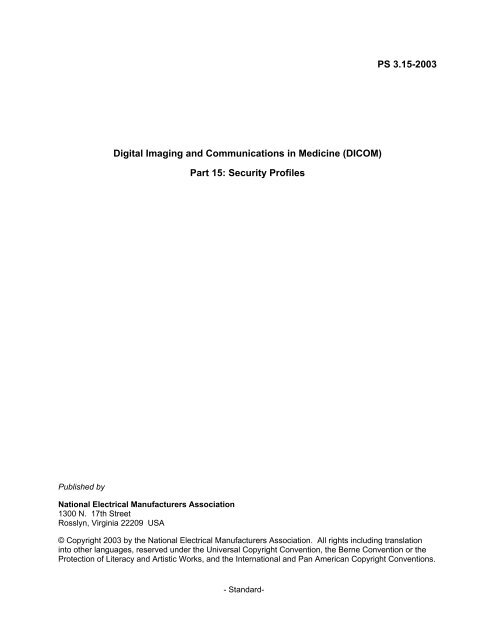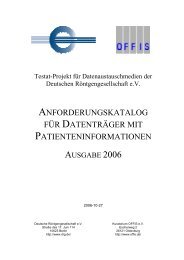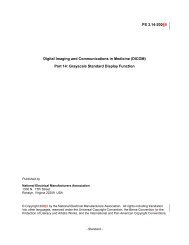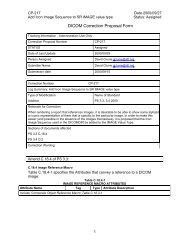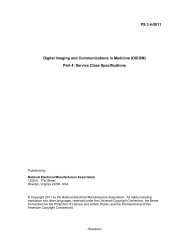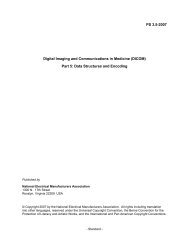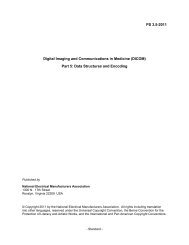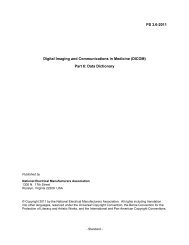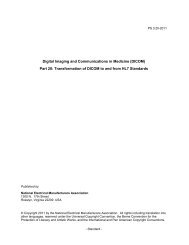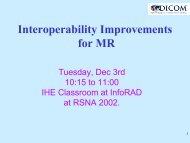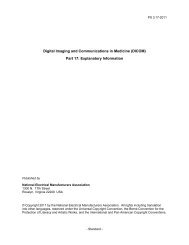Security Profiles - Dicom - NEMA
Security Profiles - Dicom - NEMA
Security Profiles - Dicom - NEMA
Create successful ePaper yourself
Turn your PDF publications into a flip-book with our unique Google optimized e-Paper software.
Published by<br />
Digital Imaging and Communications in Medicine (DICOM)<br />
National Electrical Manufacturers Association<br />
1300 N. 17th Street<br />
Rosslyn, Virginia 22209 USA<br />
Part 15: <strong>Security</strong> <strong>Profiles</strong><br />
- Standard-<br />
PS 3.15-2003<br />
© Copyright 2003 by the National Electrical Manufacturers Association. All rights including translation<br />
into other languages, reserved under the Universal Copyright Convention, the Berne Convention or the<br />
Protection of Literacy and Artistic Works, and the International and Pan American Copyright Conventions.
PS 3.15-2003<br />
Page 2<br />
NOTICE AND DISCLAIMER<br />
The information in this publication was considered technically sound by the consensus of persons<br />
engaged in the development and approval of the document at the time it was developed. Consensus<br />
does not necessarily mean that there is unanimous agreement among every person participating in the<br />
development of this document.<br />
<strong>NEMA</strong> standards and guideline publications, of which the document contained herein is one, are<br />
developed through a voluntary consensus standards development process. This process brings together<br />
volunteers and/or seeks out the views of persons who have an interest in the topic covered by this<br />
publication. While <strong>NEMA</strong> administers the process and establishes rules to promote fairness in the<br />
development of consensus, it does not write the document and it does not independently test, evaluate,<br />
or verify the accuracy or completeness of any information or the soundness of any judgments contained<br />
in its standards and guideline publications.<br />
<strong>NEMA</strong> disclaims liability for any personal injury, property, or other damages of any nature whatsoever,<br />
whether special, indirect, consequential, or compensatory, directly or indirectly resulting from the<br />
publication, use of, application, or reliance on this document. <strong>NEMA</strong> disclaims and makes no guaranty or<br />
warranty, expressed or implied, as to the accuracy or completeness of any information published herein,<br />
and disclaims and makes no warranty that the information in this document will fulfill any of your particular<br />
purposes or needs. <strong>NEMA</strong> does not undertake to guarantee the performance of any individual<br />
manufacturer or seller’s products or services by virtue of this standard or guide.<br />
In publishing and making this document available, <strong>NEMA</strong> is not undertaking to render professional or<br />
other services for or on behalf of any person or entity, nor is <strong>NEMA</strong> undertaking to perform any duty owed<br />
by any person or entity to someone else. Anyone using this document should rely on his or her own<br />
independent judgment or, as appropriate, seek the advice of a competent professional in determining the<br />
exercise of reasonable care in any given circumstances. Information and other standards on the topic<br />
covered by this publication may be available from other sources, which the user may wish to consult for<br />
additional views or information not covered by this publication.<br />
<strong>NEMA</strong> has no power, nor does it undertake to police or enforce compliance with the contents of this<br />
document. <strong>NEMA</strong> does not certify, test, or inspect products, designs, or installations for safety or health<br />
purposes. Any certification or other statement of compliance with any health or safety–related<br />
information in this document shall not be attributable to <strong>NEMA</strong> and is solely the responsibility of the<br />
certifier or maker of the statement.
Table of Contents<br />
PS 3.15-2003<br />
Page 3<br />
NOTICE AND DISCLAIMER......................................................................................................................... 2<br />
FOREWORD................................................................................................................................................. 4<br />
1 Scope and field of application ................................................................................................................ 7<br />
2 Normative references ............................................................................................................................. 8<br />
3 Definitions............................................................................................................................................... 9<br />
3.1 REFERENCE MODEL DEFINITIONS....................................................................................... 9<br />
3.2 REFERENCE MODEL SECURITY ARCHITECTURE DEFINITIONS...................................... 9<br />
3.3 ACSE SERVICE DEFINITIONS .............................................................................................. 10<br />
3.4 SECURITY DEFINITIONS....................................................................................................... 10<br />
3.5 DICOM INTRODUCTION AND OVERVIEW DEFINITIONS................................................... 10<br />
3.6 DICOM CONFORMANCE DEFINITIONS............................................................................... 10<br />
3.7 DICOM INFORMATION OBJECT DEFINITIONS ................................................................... 10<br />
3.8 DICOM SERVICE CLASS DEFINITIONS............................................................................... 10<br />
3.9 DICOM COMMUNICATION SUPPORT DEFINITIONS.......................................................... 10<br />
3.10 DICOM SECURITY PROFILE DEFINITIONS......................................................................... 10<br />
4 Symbols and abbreviations .................................................................................................................. 11<br />
5 Conventions.......................................................................................................................................... 12<br />
6 <strong>Security</strong> Profile Outlines ....................................................................................................................... 12<br />
6.1 SECURE USE PROFILES ...................................................................................................... 12<br />
6.2 SECURE TRANSPORT CONNECTION PROFILES.............................................................. 12<br />
6.3 DIGITAL SIGNATURE PROFILE ............................................................................................ 12<br />
6.4 MEDIA STORAGE SECURITY PROFILES ............................................................................ 13<br />
Annex A SECURE USE PROFILES (Normative) .................................................................................. 14<br />
A.1 ONLINE ELECTRONIC STORAGE SECURE USE PROFILE ............................................... 14<br />
A.1.1 SOP Instance Status......................................................................................................... 14<br />
A.2 BASIC DIGITAL SIGNATURES SECURE USE PROFILE ..................................................... 16<br />
A.3 BIT-PRESERVING DIGITAL SIGNATURES SECURE USE PROFILE ................................. 16<br />
Annex B SECURE TRANSPORT CONNECTION PROFILES (Normative) .......................................... 17<br />
B.1 THE BASIC TLS SECURE TRANSPORT CONNECTION PROFILE..................................... 17<br />
B.2 ISCL SECURE TRANSPORT CONNECTION PROFILE ....................................................... 18<br />
Annex C DIGITAL SIGNATURE PROFILES (Normative)...................................................................... 19<br />
C.1 BASE RSA DIGITAL SIGNATURE PROFILE......................................................................... 19<br />
C.2 CREATOR RSA DIGITAL SIGNATURE PROFILE................................................................. 19<br />
C.3 AUTHORIZATION RSA DIGITAL SIGNATURE PROFILE..................................................... 20<br />
ANNEX D– MEDIA STORAGE SECURITY PROFILES (Normative)..................................................... 21<br />
D.1 BASIC DICOM MEDIA SECURITY PROFILE......................................................................... 21<br />
D.1.1 Encapsulation of a DICOM File in a Secure DICOM File ................................................. 21<br />
ANNEX E - ATTRIBUTE CONFIDENTIALITY PROFILES......................................................................... 22<br />
E.1 BASIC APPLICATION LEVEL CONFIDENTIALITY PROFILE............................................... 22<br />
Index ................................................................................................................................................. 27
PS 3.15-2003<br />
Page 4<br />
FOREWORD<br />
The American College of Radiology (ACR) and the National Electrical Manufacturers Association (<strong>NEMA</strong>)<br />
formed a joint committee to develop a standard for Digital Imaging and Communications in Medicine<br />
(DICOM). This DICOM Standard was developed according to the <strong>NEMA</strong> procedures.<br />
This standard is developed in liaison with other standardization organizations including CEN TC251 in<br />
Europe, and JIRA and MEDIS-DC in Japan, with review also by other organizations including IEEE, HL7<br />
and ANSI in the USA.<br />
The DICOM Standard is structured as a multi-part document using the guidelines established in the<br />
following document:<br />
⎯ ISO/IEC Directives, 1989 Part 3 : Drafting and Presentation of International Standards.<br />
This document is one part of the DICOM Standard, which consists of the following parts:<br />
PS 3.1: Introduction and Overview<br />
PS 3.2: Conformance<br />
PS 3.3: Information Object Definitions<br />
PS 3.4: Service Class Specifications<br />
PS 3.5: Data Structures and Encoding<br />
PS 3.6: Data Dictionary<br />
PS 3.7: Message Exchange<br />
PS 3.8: Network Communication Support for Message Exchange<br />
PS 3.9: Retired<br />
PS 3.10: Media Storage and File Format for Media Interchange<br />
PS 3.11: Media Storage Application <strong>Profiles</strong><br />
PS 3.12: Formats and Physical Media<br />
PS 3.13: Retired<br />
PS 3.14: Grayscale Standard Display Function<br />
PS 3.15: <strong>Security</strong> <strong>Profiles</strong>
PS 3.16: Content Mapping Resource<br />
PS 3.15-2003<br />
Page 5<br />
These parts are related but independent documents. Their development level and approval status may<br />
differ. Additional parts may be added to this multi-part standard. PS 3.1 should be used as the base<br />
reference for the current parts of this standard.
1 Scope and field of application<br />
This part of the DICOM Standard specifies <strong>Security</strong> <strong>Profiles</strong> to which implementations may claim<br />
conformance.<br />
PS 3.15-2003<br />
Page 7<br />
The DICOM standard does not address issues of security policies, though clearly adherence to<br />
appropriate security policies is necessary for any level of security. The standard only provides<br />
mechanisms that could be used to implement security policies with regard to the interchange of DICOM<br />
objects between Application Entities. For example, a security policy may dictate some level of access<br />
control. This Standard does not consider access control policies, but does provide the technological<br />
means for the Application Entities involved to exchange sufficient information to implement access control<br />
policies.<br />
This Standard assumes that the Application Entities involved in a DICOM interchange are implementing<br />
appropriate security policies, including, but not limited to access control, audit trails, physical protection,<br />
maintaining the confidentiality and integrity of data, and mechanisms to identify users and their rights to<br />
access data. Essentially, each Application Entity must insure that their own local environment is secure<br />
before even attempting secure communications with other Application Entities.<br />
When Application Entities agree to interchange information via DICOM through association negotiation,<br />
they are essentially agreeing to some level of trust in the other Application Entities. Primarily Application<br />
Entities trust that their communication partners will maintain the confidentiality and integrity of data under<br />
their control. Of course that level of trust may be dictated by local security and access control policies.<br />
Application Entities may not trust the communications channel by which they communicate with other<br />
Application Entities. Thus, this Standard provides mechanisms for Application Entities to securely<br />
authenticate each other, to detect any tampering with or alteration of messages exchanged, and to<br />
protect the confidentiality of those messages while traversing the communications channel. Application<br />
Entities can optionally utilize any of these mechanisms, depending on the level of trust they place in the<br />
communications channel.<br />
This Standard assumes that Application Entities can securely identify local users of the Application Entity,<br />
and that user’s roles or licenses. Note that users may be persons, or may be abstract entities, such as<br />
organizations or pieces of equipment. When Application Entities agree to an exchange of information via<br />
DICOM, they may also exchange information about the users of the Application Entity via the Certificates<br />
exchanged in setting up the secure channel. The Application Entity may then consider the information<br />
contained in the Certificates about the users, whether local or remote, in implementing an access control<br />
policy or in generating audit trails.<br />
This Standard also assumes that Application Entities have means to determine whether or not the<br />
“owners” (e.g. patient, institution) of information have authorized particular users, or classes of users to<br />
access information. This Standard further assumes that such authorization might be considered in the<br />
access control provided by the Application Entity. At this time, this Standard does not consider how such<br />
authorization might be communicated between Application Entities, though that may be a topic for<br />
consideration at some future date.<br />
This Standard also assumes that an Application Entity using TLS has secure access to or can securely<br />
obtain X.509 key Certificates for the users of the application entity. In addition, this standard assumes<br />
that an Application Entity has the means to validate an X.509 certificate that it receives. The validation<br />
mechanism may use locally administered authorities, publicly available authorities, or some trusted third<br />
party.
PS 3.15-2003<br />
Page 8<br />
This Standard assumes that an Application Entity using ISCL has access to an appropriate key<br />
management and distribution system (e.g. smartcards). The nature and use of such a key management<br />
and distribution system is beyond the scope of DICOM, though it may be part of the security policies used<br />
at particular sites.<br />
2 Normative references<br />
The following standards contain provisions that, through reference in this text, constitute provisions of this<br />
Standard. At the time of publication, the editions indicated were valid. All standards are subject to<br />
revision, and parties to agreements based on this Standard are encouraged to investigate the possibilities<br />
of applying the most recent editions of the standards indicated below.<br />
ANSI X9.52 American National Standards Institute. ANSI X9.52-1998, Triple Data Encryption<br />
Algorithm Modes of Operation. 1998.<br />
ECMA 235, The ECMA GSS-API Mechanism<br />
FIPS PUB 46 Data Encryption Standard<br />
FIPS PUB 81 DES Modes of Operation<br />
IETF Internet X.509 Public Key Infrastructure; Time Stamp Protocols; March 2000<br />
ISO/IEC Directives, 1989 Part 3 - Drafting and Presentation of International Standards<br />
ISO/IEC 10118-:1998 Information technology – <strong>Security</strong> techniques – Hash-functions – Part 3:<br />
Dedicated hash-functions (RIPEMD-160 reference)<br />
Note: The draft RIPEMD-160 specification and sample code are also available at<br />
ftp://ftp.esat.kuleuven.ac.be/pub/bosselae/ripemd<br />
ISO 7498-1, Information Processing Systems - Open Systems Interconnection - Basic Reference<br />
Model<br />
ISO 7498-2, Information processing systems – Open Systems Interconnection – Basic reference<br />
Model – Part 2: <strong>Security</strong> Architecture<br />
ISO/TR 8509, Information Processing Systems - Open Systems Interconnection - Service<br />
Conventions<br />
ISO 8649:1987, Information Processing Systems - Open Systems Interconnection - Service<br />
Definition for the Association Control Service Element<br />
Integrated Secure Communication Layer V1.00 MEDIS-DC<br />
ITU-T Recommendation X.509 (03/00) “Information technology - Open Systems Interconnection<br />
- The directory: Public-key and attribute certificate frameworks”<br />
Note: ITU-T Recommendation X.509 is similar to ISO/IEC 9594-8 1990. However, the ITU-T<br />
recommendation is the more familiar form, and was revised in 1993 and 2000, with two<br />
sets of corrections in 2001. ITU-T was formerly known as CCITT.<br />
RFC 2246, Transport Layer <strong>Security</strong> (TLS) 1.0 Internet Engineering Task Force<br />
Note: TLS is derived from SSL 3.0, and is largely compatible with it.<br />
RFC-2313 PKCS #1: RSA Encryption, Version 1.5, March 1998.<br />
RFC 2437 PKCS #1 RSA Cryptography Specifications Version 2.0
PS 3.15-2003<br />
Page 9<br />
Note: The RSA Encryption Standard is also defined in informative annex A of ISO/IEC 9796, and<br />
in Normative Annex A of the CEN/TC251 European Prestandard prENV 12388:1996.<br />
RFC-2630 Cryptographic Message Syntax, June 1999<br />
SHA-1 National Institute of Standards and Technology, FIPS Pub 180-1: Secure Hash<br />
Standard, 17 April 1995<br />
3 Definitions<br />
For the purposes of this Standard the following definitions apply.<br />
3.1 REFERENCE MODEL DEFINITIONS<br />
This part of the Standard makes use of the following terms defined in ISO 7498-1:<br />
a. Application Entity<br />
b. Protocol Data Unit or Layer Protocol Data Unit<br />
c. Transport Connection<br />
3.2 REFERENCE MODEL SECURITY ARCHITECTURE DEFINITIONS<br />
This Part of the Standard makes use of the following terms defined in ISO 7498-2:<br />
a. Data Confidentiality<br />
Note: The definition is “the property that information is not made available or disclosed to unauthorized<br />
individuals, entities or processes.”<br />
b. Data Origin Authentication<br />
Note: The definition is “the corroboration that the source of data received is as claimed.”<br />
c. Data Integrity<br />
Note: The definition is “the property that data has not been altered or destroyed in an unauthorized manner.”<br />
d. Key Management<br />
Note: The definition is “the generation, storage, distribution, deletion, archiving and application of keys in<br />
accordance with a security policy.”<br />
e. Digital Signature<br />
Note: The definition is “Data appended to, or a cryptographic transformation of, a data unit that allows a<br />
recipient of the data unit to prove the source and integrity of that unit and protect against forgery e.g. by<br />
the recipient.”
PS 3.15-2003<br />
Page 10<br />
3.3 ACSE SERVICE DEFINITIONS<br />
This part of the Standard makes use of the following terms defined in ISO 8649:<br />
a. Association or Application Association<br />
3.4 SECURITY DEFINITIONS<br />
This Part of the Standard makes use of the following terms defined in ECMA 235:<br />
a. <strong>Security</strong> Context<br />
Note: The definition is “security information that represents, or will represent a <strong>Security</strong> Association to an<br />
initiator or acceptor that has formed, or is attempting to form such an association.”<br />
3.5 DICOM INTRODUCTION AND OVERVIEW DEFINITIONS<br />
This Part of the Standard makes use of the following terms defined in PS 3.1:<br />
a. Attribute<br />
3.6 DICOM CONFORMANCE DEFINITIONS<br />
This Part of the Standard makes use of the following terms defined in PS 3.2:<br />
a. <strong>Security</strong> Profile<br />
3.7 DICOM INFORMATION OBJECT DEFINITIONS<br />
This Part of the Standard makes use of the following terms defined in PS 3.3:<br />
a. Module<br />
3.8 DICOM SERVICE CLASS DEFINITIONS<br />
This Part of the Standard makes use of the following terms defined in PS 3.4:<br />
a. Service Class<br />
b. Service-Object Pair (SOP) Instance<br />
3.9 DICOM COMMUNICATION SUPPORT DEFINITIONS<br />
This Part of the Standard makes use of the following terms defined in PS 3.8:<br />
a. DICOM Upper Layer<br />
3.10 DICOM SECURITY PROFILE DEFINITIONS<br />
The following definitions are commonly used in this Part of the DICOM Standard:<br />
Secure Transport Connection: a Transport Connection that provides some level of protection against<br />
tampering, eavesdropping, masquerading.<br />
Message Authentication Code: A digest or hash code derived from a subset of Data Elements.
PS 3.15-2003<br />
Page 11<br />
Certificate: An electronic document that identifies a party and that party’s public encryption algorithm,<br />
parameters, and key. The Certificate also includes, among other things, the identity and a digital<br />
signature from the entity that created the certificate. The content and format of a Certificate are defined<br />
by ITU-T Recommendation X.509.<br />
4 Symbols and abbreviations<br />
The following symbols and abbreviations are used in this Part of the Standard.<br />
ACR American College of Radiology<br />
AE Application Entity<br />
ANSI American National Standards Institute<br />
CEN TC251 Comite European de Normalisation-Technical Committee 251-Medical<br />
Informatics<br />
CBC Cipher Block Chaining<br />
CCIR Consultative Committee, International Radio<br />
DES Data Encryption Standard<br />
DICOM Digital Imaging and Communications in Medicine<br />
ECMA European Computer Manufacturers Association<br />
EDE Encrypt-Decrypt-Encrypt<br />
HL7 Health Level 7<br />
IEEE Institute of Electrical and Electronics Engineers<br />
IEC International Electrical Commission<br />
IOD Information Object Definition<br />
ISCL Integrated Secure Communication Layer<br />
ISO International Standards Organization<br />
JIRA Japan Industries association of RAdiological systems<br />
MAC Message Authentication Code<br />
MD-5 Message Digest - 5<br />
MEDIS-DC Medical Information System Development Center<br />
<strong>NEMA</strong> National Electrical Manufacturers Association<br />
PDU Protocol Data Unit<br />
RSA Rivest-Shamir-Adleman<br />
SCP Service Class Provider<br />
SCU Service Class User<br />
SHA Secure Hash Algorithm<br />
SOP Service-Object Pair<br />
SSL Secure Sockets Layer<br />
TLS Transport Layer <strong>Security</strong><br />
UID Unique Identifier
PS 3.15-2003<br />
Page 12<br />
5 Conventions<br />
Terms listed in Section 3 Definitions are capitalized throughout the document.<br />
6 <strong>Security</strong> Profile Outlines<br />
An implementation may claim conformance to any of the <strong>Security</strong> <strong>Profiles</strong> individually. It may also claim<br />
conformance to more than one <strong>Security</strong> Profile. It shall indicate in its Conformance Statement how it<br />
chooses which profiles to use for any given transaction.<br />
6.1 SECURE USE PROFILES<br />
An implementation may claim conformance to one or more Secure Use <strong>Profiles</strong>. Such profiles outline the<br />
use of attributes and other <strong>Security</strong> <strong>Profiles</strong> in a specific fashion.<br />
Secure Use <strong>Profiles</strong> are specified in Annex A.<br />
6.2 SECURE TRANSPORT CONNECTION PROFILES<br />
An implementation may claim conformance to one or more Secure Transport Connection <strong>Profiles</strong>.<br />
A Secure Transport Connection Profile includes the following information:<br />
a. Description of the protocol framework and negotiation mechanisms<br />
b. Description of the entity authentication an implementation shall support<br />
1. The identity of the entities being authenticated<br />
2. The mechanism by which entities are authenticated<br />
3. Any special considerations for audit log support<br />
c. Description of the encryption mechanism an implementation shall support<br />
1. The method of distributing session keys<br />
2. The encryption protocol and relevant parameters<br />
d. Description of the integrity check mechanism an implementation shall support<br />
Secure Transport Connection <strong>Profiles</strong> are specified in Annex B.<br />
6.3 DIGITAL SIGNATURE PROFILE<br />
An implementation may claim conformance to one or more Digital Signature <strong>Profiles</strong>.<br />
A Digital Signature profile consists of the following information:<br />
a. The role that the Digital Signature plays, including:<br />
1. Who or what entity the Digital Signature represents.<br />
2. A description of the purpose of the Digital Signature.<br />
3. The conditions under which the Digital Signature is included in the Data Set.<br />
b. A list of Attributes that shall be included in the Digital Signature.<br />
c. The mechanisms that shall be used to generate or verify the Digital Signature, including:
PS 3.15-2003<br />
Page 13<br />
1. The algorithm and relevant parameters that shall be used to create the MAC or hash code,<br />
including the Value to be used for the MAC Algorithm (0400,0015) Attribute.<br />
2. The encryption algorithm and relevant parameters that shall be used to encrypt the MAC or<br />
hash code in forming the Digital Signature.<br />
3. The certificate type or key distribution mechanism that shall be used, including the Value to<br />
be used for the Certificate Type (0400,0110) Attribute.<br />
4. Any requirements for the Certified Timestamp Type (0400,305) and Certified Timestamp<br />
(0400,310) Attributes.<br />
d. Any special requirements for identifying the signatory.<br />
e. The relationship with other Digital Signatures, if any.<br />
f. Any other factors needed to create, verify, or interpret the Digital Signature<br />
Digital Signature <strong>Profiles</strong> are specified in Annex C.<br />
6.4 MEDIA STORAGE SECURITY PROFILES<br />
An implementation may claim conformance to one or more Media Storage Application <strong>Profiles</strong> which in<br />
turn require conformance to one or more Media Storage <strong>Security</strong> <strong>Profiles</strong>.<br />
Note: An implementation may not claim conformance to a Media Storage <strong>Security</strong> Profile without claiming<br />
conformance to a Media Storage Application Profile.<br />
A Media Storage <strong>Security</strong> Profile includes the following specifications:<br />
a. What aspects of security are addressed by the profile.<br />
b. The restrictions on the types of DICOM Files that can be secured, if any.<br />
c. How the DICOM Files will be encapsulated and secured.<br />
Media Storage <strong>Security</strong> <strong>Profiles</strong> are specified in Annex D.
PS 3.15-2003<br />
Page 14<br />
Annex A SECURE USE PROFILES<br />
(Normative)<br />
A.1 ONLINE ELECTRONIC STORAGE SECURE USE PROFILE<br />
The Online Electronic Storage Secure Use Profile allows Application Entities to track and verify the status<br />
of SOP Instances in those cases where local security policies require tracking of the original data set and<br />
subsequent copies.<br />
The Conformance Statement shall indicate in what manner the system restricts remote access.<br />
A.1.1 SOP Instance Status<br />
An implementation that conforms to the Online Electronic Storage Secure Use Profile shall conform to<br />
the following rules regarding the use of the SOP Instance Status (0100,0410) Attribute with SOP<br />
Instances that are transferred using the Storage Service Class:<br />
a. An Application Entity that supports the Online Electronic Storage Secure Use Profile and that<br />
creates a SOP Instance intended for diagnostic use in Online Electronic Storage shall:<br />
1. Set the SOP Instance Status to Original (OR).<br />
2. Include the following Attributes:<br />
a) the SOP Class UID (0008,0016) and SOP Instance UID (0008,0018)<br />
b) the Instance Creation Date (0008,0012) and Instance Creation Time (0008,0013), if<br />
known<br />
c) the SOP Instance Status<br />
d) the SOP Authorization Date and Time (0100,0420)<br />
e) the SOP Authorization Comment, if any (0100,0424)<br />
f) the SOP Equipment Certification Number (0100,0426)<br />
g) the Study Instance UID (0020,000D) and Series Instance UID (0020,000E)<br />
h) any Attributes of the General Equipment Module that are known<br />
i) any overlay data present<br />
j) any image data present<br />
b. The Application Entity that holds a SOP Instance where the SOP Instance Status is Original (OR)<br />
may change the SOP Instance Status to Authorized Original(AO) as long as the following rules<br />
are followed:<br />
1. The Application Entity shall determine that an authorized entity has certified the SOP<br />
Instance as useable for diagnostic purposes.<br />
2. The Application Entity shall change the SOP Instance Status to Authorized Original (AO).<br />
The SOP Instance UID shall not change.<br />
3. The Application Entity shall set the SOP Authorization Date and Time (0100,0420) and<br />
Authorization Equipment Certification Number (0100,0426) Attributes to appropriate values.<br />
It may also add an appropriate SOP Authorization Comment (0100,0424) Attribute.<br />
c. There shall only be one Application Entity that holds a SOP Instance where the SOP Instance<br />
Status is Original (OR) or Authorized Original (AO). The Application Entity that holds such a SOP<br />
instance shall not delete it.<br />
d. When communicating with an Application Entity that supports Online Electronic Storage the<br />
Application Entity that holds a SOP Instance where the SOP Instance Status is Original(OR) or
PS 3.15-2003<br />
Page 15<br />
Authorized Original(AO) may transfer that SOP Instance to another Application Entity that also<br />
conforms to the Online Electronic Storage Secure Use Profile as long as the following rules are<br />
followed:<br />
1. The transfer shall occur on a Secure Transport Connection.<br />
2. The two Application Entities involved in the transfer shall authenticate each other and shall<br />
confirm via the authentication that the other supports the Online Electronic Storage Secure<br />
Use Profile.<br />
3. The receiving Application Entity shall reject the storage request and discard the received<br />
SOP Instance if the data integrity checks done after the transfer indicate that the SOP<br />
Instance was altered during transmission.<br />
4. The transfer shall be confirmed using the push model of the Storage Commitment Service<br />
Class. Until it has completed this confirmation, the receiving Application Entity shall not<br />
forward the SOP Instance or Authorized Copies of the SOP instance to any other Application<br />
Entity.<br />
5. Once confirmed that the receiving Application Entity has successfully committed the SOP<br />
Instance to storage, the sending Application Entity shall do one of the following to its local<br />
copy of the SOP Instance:<br />
a) delete the SOP Instance,<br />
b) change the SOP Instance Status to Not Specified (NS),<br />
c) if the SOP Instance Status was Authorized Original (AO), change the SOP Instance<br />
Status to Authorized Copy (AC).<br />
e. When communicating with an Application Entity that supports Online Electronic Storage an<br />
Application Entity that holds a SOP Instance whose SOP Instance Status is Authorized Original<br />
(AO) or Authorized Copy (AC) may send an Authorized Copy of the SOP Instance to another<br />
Application Entity as long as the following rules are followed:<br />
1. The transfer shall occur on a Secure Transport Connection.<br />
2. The two Application Entities involved in the transfer shall authenticate each other, and shall<br />
confirm via the authentication that the other supports the Online Electronic Storage Secure<br />
Use Profile.<br />
3. The sending Application Entity shall set the SOP Instance Status to either Not Specified (NS)<br />
or Authorized Copy (AC) in the copy sent. The SOP Instance UID shall not change.<br />
4. The receiving Application Entity shall reject the storage request and discard the copy if data<br />
integrity checks done after the transfer indicate that the SOP Instance was altered during<br />
transmission.<br />
f. If communicating with a system that does not support the Online Electronic Storage Secure Use<br />
Profile, or if communication is not done over a Secure Transport Connection, then<br />
1. A sending Application Entity that conforms to this <strong>Security</strong> Profile shall either set the SOP<br />
Instance Status to Not Specified (NS), or leave out the SOP Instance Status and associated<br />
parameters of any SOP Instances that the sending Application Entity sends out over the<br />
unsecured Transport Connection or to systems that do not support the Online Electronic<br />
Storage Secure Use Profile.<br />
2. A receiving Application Entity that conforms to this <strong>Security</strong> Profile shall set the SOP Instance<br />
Status to Not Specified (NS) of any SOP Instance received over the unsecured Transport<br />
Connection or from systems that do not support the Online Electronic Storage Secure Use<br />
Profile.<br />
g. The receiving Application Entity shall store SOP Instances in accordance with Level 2 as defined<br />
in the Storage Service Class (i.e., all Attributes, including Private Attributes), as required by the<br />
Storage Commitment Storage Service Class, and shall not coerce any Attribute other than SOP<br />
Instance Status, SOP Authorization Date and Time, Authorization Equipment Certification<br />
Number, and SOP Authorization Comment.
PS 3.15-2003<br />
Page 16<br />
h. Other than changes to the SOP Instance Status, SOP Authorization Date and Time, Authorization<br />
Equipment Certification Number, and SOP Authorization Comment Attributes, as outlined above,<br />
or changes to group length Attributes to accommodate the aforementioned changes, the<br />
Application Entity shall not change any Attribute values.<br />
A.2 BASIC DIGITAL SIGNATURES SECURE USE PROFILE<br />
An implementation that validates and generates Digital Signatures may claim conformance to the Basic<br />
Digital Signatures Secure Use Profile. Any implementation that claims conformance to this <strong>Security</strong><br />
Profile shall obey the following rules in handling Digital Signatures:<br />
a. The implementation shall store any SOP Instances that it receives in such a way that it guards<br />
against any unauthorized tampering of the SOP Instance.<br />
b. Wherever possible, the implementation shall validate the Digital Signatures within any SOP<br />
Instance that it receives.<br />
c. If the implementation sends the SOP Instance to another Application Entity, it shall do the<br />
following:<br />
1. remove any Digital Signatures that may have become invalid due to any allowed variations to<br />
the format of Attribute Values (e.g. trimming of padding, alternate representations of<br />
numbers),<br />
2. generate one or more new Digital Signatures covering the Data Elements that the<br />
implementation was able to verify when the SOP Instance was received.<br />
A.3 BIT-PRESERVING DIGITAL SIGNATURES SECURE USE PROFILE<br />
An implementation that stores and forwards SOP Instances may claim conformance to the Bit-Preserving<br />
Digital Signatures Secure Use Profile. Any implementation that claims conformance to this <strong>Security</strong><br />
Profile shall obey the following rules in handling Digital Signatures:<br />
a. The implementation shall store any SOP Instances that it receives in such a way that when the<br />
SOP instance is forwarded to another Application Entity, the Value fields of all Attributes are bitfor-bit<br />
duplicates of the fields originally received.<br />
b. The implementation shall not change the order of Items in a Sequence.<br />
c. The implementation shall not remove or change any Data Element of any SOP Instance that it<br />
receives when sending that SOP Instance on to another Application Entity via DICOM. This<br />
includes any Digital Signatures received.<br />
Note: Implementations may add new Data Elements that do not alter any existing Digital Signatures.<br />
d. The implementation shall utilize an explicit VR Transfer Syntax.<br />
Note: Implementations that cannot use an explicit VR Transfer Syntax cannot conform to this Secure Use<br />
Profile, since it may not be able to verify Digital Signatures that are received with an implicit VR Transfer<br />
Syntax.<br />
e. The implementation shall not change the VR of any Data Element that it receives when it<br />
transmits that object to another Application Entity.
Annex B SECURE TRANSPORT CONNECTION PROFILES<br />
(Normative)<br />
B.1 THE BASIC TLS SECURE TRANSPORT CONNECTION PROFILE<br />
PS 3.15-2003<br />
Page 17<br />
An implementation that supports the Basic TLS Secure Transport Connection Profile shall utilize the<br />
framework and negotiation mechanism specified by the Transport Layer <strong>Security</strong> Version 1.0 protocol.<br />
Table B.1-1 specifies mechanisms that shall be supported if the corresponding features within TLS are<br />
supported by the Application Entity. The profile does not require the implementation to support all of the<br />
features (entity authentication, encryption, integrity checks) of TLS. Other mechanisms may also be used<br />
if agreed to by negotiation during establishment of the TLS channel.<br />
Table B.1-1<br />
Minimum Mechanisms for TLS Features<br />
Supported TLS Feature Minimum Mechanism<br />
Entity Authentication RSA based certificates<br />
Exchange of Master Secrets RSA<br />
Data Integrity SHA<br />
Privacy Triple DES EDE, CBC<br />
IP ports on which an implementation accepts TLS connections, or the mechanism by which this port<br />
number is selected or configured, shall be specified in the Conformance Statement. This port shall be<br />
different from ports used for other types of transport connections (secure or unsecure).<br />
Note: It is strongly recommended that systems supporting the Basic TLS Secure Transport Connection Profile<br />
use as their port the registered port number “2762 dicom-tls” for the DICOM Upper Layer Protocol on<br />
TLS: (decimal).<br />
The Conformance Statement shall also indicate what mechanisms the implementation supports for Key<br />
Management.<br />
The profile does not specify how a TLS Secure Transport Connection is established, or the significance of<br />
any certificates exchanged during peer entity authentication. These issues are left up to the Application<br />
Entity, which presumably is following some site specified security policy. The identities of the certificate<br />
owners can by used by the application entity for audit log support, or to restrict access based on some<br />
external access rights control framework. Once the Application Entity has established a Secure<br />
Transport Connection, then an Upper Layer Association can use that secure channel.<br />
Note: There may be an interaction between PDU size and TLS Record size that impacts efficiency of transport.<br />
The maximum allowed TLS record size is smaller than the maximum allowed PDU size.<br />
When an integrity check fails, the connection shall be dropped per the TLS protocol, causing both the<br />
sender and the receiver to issue an A-P-ABORT indication to the upper layers with an implementationspecific<br />
provider reason. The provider reason used shall be documented in the conformance statement.<br />
Note: An integrity check failure indicates that the security of the channel may have been compromised.
PS 3.15-2003<br />
Page 18<br />
B.2 ISCL SECURE TRANSPORT CONNECTION PROFILE<br />
An implementation that supports the ISCL Transport Connection Profile shall utilize the framework and<br />
negotiation mechanism specified by the Integrated Secure Communication Layer, V1.00. An Application<br />
Entity shall use ISCL to select the mechanisms specified in Table B.2-1. An Application Entity shall as a<br />
minimum use an Entity Authentication mechanism and Data Integrity checks. An Application Entity may<br />
optionally use a privacy mechanism.<br />
Table B.2-1<br />
Minimum Mechanisms for ISCL Features<br />
Supported ISCL Feature Minimum Mechanism<br />
Entity Authentication Three pass (four-way) authentication<br />
(ISO/IEC 9798-2)<br />
Data Integrity Either MD-5 encrypted with DES,<br />
or DES-MAC (ISO 8730)<br />
Privacy DES (see Note)<br />
Notes: The use of DES for privacy is optional for Online Electronic Storage.<br />
For the Data Integrity check, an implementation may either encrypt the random number before applying<br />
MD-5, or encrypt the output of MD-5. The order is specified in the protocol. A receiver shall be able to<br />
perform the integrity check on messages regardless of the order.<br />
IP ports on which an implementation accepts ISCL connections, or the mechanism by which this port<br />
number is selected or configured, shall be specified in the Conformance Statement. This port shall be<br />
different from ports used for other types of transport connections (secure or unsecure).<br />
Note: It is strongly recommended that systems supporting the ISCL Secure Transport Connection Profile use<br />
as their port the registered port number “2761 dicom-iscl” for the DICOM Upper Layer Protocol on ISCL.<br />
The Conformance Statement shall also indicate what mechanisms the implementation supports for Key<br />
Management.<br />
The profile does not specify how an ISCL Secure Transport Connection is established. This issue is left<br />
up to the Application Entity, which presumably is following some site specified security policy. Once the<br />
Application Entity has established a Secure Transport Connection, then an Upper Layer Association can<br />
use that secure channel.<br />
Note: There may be an interaction between PDU size and ISCL record size that impacts efficiency of transport.<br />
When an integrity check fails, the connection shall be dropped, per the ISCL protocol, causing both the<br />
sender and the receiver to issue an A-P-ABORT indication to the upper layers with an implementationspecific<br />
provider reason. The provider reason used shall be documented in the conformance statement.<br />
Note: An integrity check failure indicates that the security of the channel may have been compromised.
Annex C DIGITAL SIGNATURE PROFILES<br />
(Normative)<br />
C.1 BASE RSA DIGITAL SIGNATURE PROFILE<br />
PS 3.15-2003<br />
Page 19<br />
The Base RSA Digital Signature Profile outlines the use of RSA encryption of a MAC to generate a Digital<br />
Signature. This Profile does not specify any particular set of Data Elements to sign. Other Digital<br />
Signature profiles may refer to this profile, adding specifications of which Data Elements to sign or other<br />
customizations.<br />
The creator of a digital signature shall use one of the RIPEMD-160, MD5, or SHA-1 hashing functions to<br />
generate a MAC, which is then encrypted using a private RSA key. All validators of digital signatures shall<br />
be capable of using a MAC generated by any of three hashing functions specified (RIPEMD-160, MD5, or<br />
SHA-1).<br />
Note: The use of MD5 is not recommended by its inventors, RSA. See:<br />
ftp://ftp.rsasecurity.com/pub/pdfs/bulletn4.pdf<br />
The MAC to be signed shall be padded to a block size matching the RSA key size, as directed in RFC<br />
2437 (PKCS #1). The Value of MAC Algorithm (0400,0015) shall be set to either "RIPEMD160", “MD5”,<br />
or “SHA1”. The public key associated with the private key as well as the identity of the Application Entity<br />
or equipment manufacturer that owns the RSA key pair shall be transmitted in an X.509 (1993) signature<br />
certificate. The Value of the Certificate Type (0400,0110) Attribute shall be set to "X509_1993_SIG". A<br />
site-specific policy determines how the X.509 certificates are generated, authenticated, and distributed. A<br />
site may issue and distribute X.509 certificates directly, may utilize the services of a Certificate Authority,<br />
or use any reasonable method for certificate generation and verification.<br />
If an implementation utilizes timestamps, it shall use a Certified Timestamp Type (0400,0305) of<br />
“CMS_TSP”. The Certified Timestamp (0400,0310) shall be generated as described in “Internet X.509<br />
Public Key Infrastructure; Time Stamp Protocols; March 2000”.<br />
C.2 CREATOR RSA DIGITAL SIGNATURE PROFILE<br />
The creator of a DICOM SOP Instance may generate signatures using the Creator RSA Digital Signature<br />
Profile. The Digital Signature produced by this Profile serves as a lifetime data integrity check that can be<br />
used to verify that the pixel data in the SOP instance has not been altered since its initial creation. An<br />
implementation that supports the Creator RSA Digital Signature Profile may include a Creator RSA Digital<br />
Signature with every SOP Instance that it creates; however, the implementation is not required to do so.<br />
As a minimum, an implementation shall include the following attributes in generating the Creator RSA<br />
Digital Signature:<br />
a. the SOP Class and Instance UIDs<br />
b. the SOP Creation Date and Time, if present<br />
c. the Study and Series Instance UIDs<br />
d. any attributes of the General Equipment module that are present<br />
e. any attributes of the Overlay Plane, Curve or Graphic Annotation modules that are present<br />
f. any attributes of the General Image and Image Pixel modules that are present<br />
g. any attributes of the SR Document General and SR Document Content modules that are present
PS 3.15-2003<br />
Page 20<br />
h. any attributes of the Waveform and Waveform Annotation modules that are present<br />
The Digital Signature shall be created using the methodology described in the Base RSA Digital<br />
Signature Profile. Typically the certificate and associated private key used to produce Creator RSA<br />
Digital Signatures are configuration parameters of the Application Entity set by service or installation<br />
engineers.<br />
Creator RSA Digital Signatures bear no direct relationship to other Digital Signatures. However, other<br />
Digital Signatures, such as the Authorization Digital Signature, may be used to collaborate the timestamp<br />
of a Creator RSA Digital Signature.<br />
C.3 AUTHORIZATION RSA DIGITAL SIGNATURE PROFILE<br />
The technician or physician who approves a DICOM SOP Instance for use may request the Application<br />
Entity to generate a signature using the Authorization RSA Digital Signature Profile. The Digital<br />
Signature produced serves as a lifetime data integrity check that can be used to verify that the pixel data<br />
in the SOP instance is the same that the technician or physician saw when they made the approval.<br />
As a minimum, an implementation shall include the following attributes in generating the Authorization<br />
RSA Digital Signature:<br />
a. the SOP Class and Instance UIDs<br />
b. the Study and Series Instance UIDs<br />
c. any attributes whose Values are verifiable by the technician or physician (e.g., their Values<br />
are displayed to the technician or physician)<br />
d. any attributes of the Overlay Plane, Curve or Graphic Annotation modules that are present<br />
e. any attributes of the General Image and Image Pixel modules that are present<br />
f. any attributes of the SR Document General and SR Document Content modules that are<br />
present<br />
g. any attributes of the Waveform and Waveform Annotation modules that are present<br />
The Digital Signature shall be created using the methodology described in the Base RSA Digital<br />
Signature Profile. The Application Entity shall determine the identity of the technician or physician and<br />
obtain their certificate through a site-specific procedure such as a login mechanism or a smart card.<br />
Authorization RSA Digital Signatures bear no direct relationship to other Digital Signatures. However,<br />
other Digital Signatures, such as the Creator RSA Digital Signature, may be used to collaborate the<br />
timestamp of an Authorization RSA Digital Signature.
ANNEX D– MEDIA STORAGE SECURITY PROFILES<br />
(Normative)<br />
D.1 BASIC DICOM MEDIA SECURITY PROFILE<br />
PS 3.15-2003<br />
Page 21<br />
The Basic DICOM Media <strong>Security</strong> Profile allows encapsulation of a DICOM File into a Secure DICOM File<br />
such that the following aspects of security are addressed:<br />
— confidentiality,<br />
— integrity,<br />
— data origin authentication (optional).<br />
This profile specifies the use of Triple-DES for content encryption and RSA for the key transport of Triple-<br />
DES content-encryption keys. The encrypted content is a DICOM File which can either<br />
— be signed with one or more digital signatures, using SHA-1 as the digest algorithm and RSA<br />
as the signature algorithm, or<br />
— be digested with SHA-1 as digest algorithm, without application of digital signatures.<br />
D.1.1 Encapsulation of a DICOM File in a Secure DICOM File<br />
A Secure DICOM File conforming to this security profile shall contain an Enveloped-data content type of<br />
the Cryptographic Message Syntax defined in RFC 2630. The enveloped data shall use RSA [RFC 2313]<br />
for the key transport of Triple-DES content-encryption keys. The Triple-DES key length is 168 bits as<br />
defined by ANSI X9.52. Encoding shall be performed according to the specifications for RSA Key<br />
Transport in RFC-2630.<br />
The encrypted content of the Enveloped-data content type shall be of the following choices:<br />
— Signed-data content type;<br />
— Digested-data content type.<br />
In both cases, SHA-1 [SHA-1] shall be used as the digest algorithm. In case of the Signed-data content<br />
type, RSA [RFC 2313] shall be used as the signature algorithm.<br />
Notes: 1. RSA key transport of Triple-DES content-encryption keys is specified as a requirement in the<br />
European Prestandard ENV 13608-2: Health Informatics - <strong>Security</strong> for healthcare communication –<br />
Part 2: Secure data objects.<br />
2. No requirements on the size of the asymmetric key pairs used for RSA key transport are defined in this<br />
profile.<br />
3. No requirements or restrictions on the use of the SignedAttributes element of the Signed-data content<br />
type’s SignerInfo structure are defined in this profile. SignedAttributes might for example be used to<br />
specify the signing time or SMIME capabilities, as required by ENV 13608-2.
PS 3.15-2003<br />
Page 22<br />
ANNEX E - ATTRIBUTE CONFIDENTIALITY PROFILES<br />
E.1 BASIC APPLICATION LEVEL CONFIDENTIALITY PROFILE<br />
This Basic Application Level Confidentiality Profile addresses the following aspects of security:<br />
— Data Confidentiality at the application level.<br />
Other aspects of security not addressed by this profile, that may be addressed elsewhere in the standard<br />
include:<br />
— Confidentiality in other layers of the DICOM model;<br />
— Data Integrity.<br />
This Profile is targeted toward creating a special purpose, de-identified version of an already-existing<br />
Data Set. It is not intended to replace the original SOP Instance from which the de-identified SOP<br />
Instance is created, nor is it intended to act as the primary representation of clinical Data Sets in image<br />
archives. The de-identified SOP Instances are useful, for example, in creating teaching or research files,<br />
where the identity of the patient should be protected, but still be accessible to authorized personnel.<br />
E.1.1 De-Identifier<br />
An Application may claim conformance to the Basic Application Level Confidentiality Profile as a deidentifier<br />
if it protects all Attributes that might be used by unauthorized entities to identify the patient.<br />
Protection in this context is defined as the following process:<br />
1. The application may create one or more instances of the Encrypted Attributes Data Set and copy<br />
Attributes to be protected into the (single) item of the Modified Attributes Sequence (0400,0550) of<br />
one or more of the Encrypted Attributes Data Set instances.<br />
Note: A complete reconstruction of the original Data Set may not be possible; however, Attributes (e.g. SOP<br />
Instance UID) in the Modified Attributes Sequence of an Encrypted Attributes Data Set may refer back<br />
to the original SOP Instance holding the original Data Set.<br />
2. Each Attribute to be protected shall then either be removed from the dataset, or have its value<br />
replaced by a different “replacement value” which does not allow identification of the patient.<br />
Note: 1. It is the responsibility of the de-identifier to ensure that this process does not negatively affect the<br />
integrity of the Information Object Definition, i. e. Dummy values may be necessary for Type 1<br />
Attributes that are protected but may not be sent with zero length, and are to be stored or exchanged in<br />
encrypted form by applications that may not be aware of the security machanism.<br />
2. The standard does not mandate the use of any particular dummy value, and indeed it may have some<br />
meaning, for example in a data set that may be used for teaching purposes, where the real patient<br />
identifying information is encrypted for later retrieval, but a meaningful alternative form of identification<br />
is provided. For example, a dummy Patient’s Name (0010,0010) may convey the type of pathology in a<br />
teaching case. It is the responsibility of the de-identifier to ensure that the dummy values cannot be<br />
used to identify the patient.<br />
3. It is the responsibility of the de-identifier to ensure the consistency of dummy values for Attributes such<br />
as Study Instance UID (0020,000D) or Frame of Reference UID (0020,0052) if multiple related SOP<br />
Instances are protected.<br />
4. This standard does not allow selective protection of parts of a Sequence of Items. If an Attribute to be<br />
protected is contained in a Sequence of Items, the complete Sequence of Items needs to be protected.<br />
5. The de-identifier should ensure that identifying information that is burned in to the image pixel data is<br />
“blackened” (removed). The means by which identifying information is located and removed is outside<br />
the scope of this standard.
3. At the discretion of the de-identifier, Attributes may be added to the dataset to be protected.<br />
PS 3.15-2003<br />
Page 23<br />
Note: As an example, the Attribute Patient’s Age (0010,1010) might be introduced as a replacement for<br />
Patient’s Birth Date (0010,0030) if the patient’s age is of importance.<br />
4. All instances of the Encrypted Attributes Data Set shall be encoded with a DICOM Transfer Syntax,<br />
encrypted , and stored in the dataset to be protected as an Item of the Encrypted Attributes<br />
Sequence (0400,0500). The encryption shall be done using RSA [RFC 2313] for the key transport of<br />
Triple-DES content-encryption keys. The Triple-DES key length is 168 bits as defined by ANSI X9.52.<br />
Encoding shall be performed according to the specifications for RSA Key Transport in RFC-2630.<br />
Note: 1. Each item of the Encrypted Attributes Sequence (0400,0500) consists of two Attributes, Encrypted<br />
Content Transfer Syntax UID (0400,0510) containing the UID of the Transfer Syntax that was used to<br />
encode the instance of the Encrypted Attributes Data Set, and Encrypted Content (0400,0520)<br />
containing the block of data resulting from the encryption of the Encrypted Attributes Data Set instance.<br />
2. RSA key transport of Triple-DES content-encryption keys is specified as a requirement in the<br />
European Prestandard ENV 13608-2: Health Informatics - <strong>Security</strong> for healthcare communication –<br />
Part 2: Secure data objects.<br />
3. No requirements on the size of the asymmetric key pairs used for RSA key transport are defined in<br />
this confidentiality scheme.Implementations claiming conformance to the Basic Application Level<br />
Confidentiality Profile as a de-identifier shall always protect (e.g. encrypt and replace) the SOP Instance<br />
UID (0008,0018) Attribute as well as all references to other SOP Instances, whether contained in the<br />
main dataset or embedded in an Item of a Sequence of Items, that could potentially be used by<br />
unauthorized entities to identify the patient.<br />
Note: In the case of a SOP Instance UID embedded in an item of a sequence, this means that the enclosing<br />
Attribute in the top-level data set must be encrypted in its entirety.<br />
The Attributes listed in Table E.1-1 contained in Standard IODs typically need to be protected to provide a<br />
minimal level of confidentiality from identification. An implementation claiming conformance to the Basic<br />
Application Level Confidentiality Profile as a de-identifier shall protect all instances of the Attributes listed<br />
in Table E.1-1, whether contained in the main dataset or embedded in an Item of a Sequence of Items,<br />
unless the implementation can ensure that the content of these Attributes cannot be used by<br />
unauthorized entities to identify the patient.<br />
Notes: 1. The Attributes listed in Table E.1-1 may not be sufficient to guarantee confidentiality of patient identity.<br />
In particular, identifying information may be contained in Private Attributes, Curves or Overlays. It is the<br />
responsibility of the de-identifier to ensure that all identifying information is removed.<br />
2. It should be noted that conformance to the Basic Application Level Confidentiality Profile does not<br />
necessarily guarantee confidentiality. Any encryption scheme may be vulnerable to attack. Also, an<br />
organization’s <strong>Security</strong> Policy and Key Management policy are recognized to have a much greater impact<br />
on the effectiveness of protection.<br />
3. If the image pixel data contains ‘burned in’ identifications, the de-identifier may ‘black’ them out to deidentify<br />
the pixel data.<br />
4. National and local regulations, which may vary, might require that additional attributes be de-identified.<br />
Table E.1-1<br />
Basic Application Level Confidentiality Profile Attributes<br />
Attribute Name Tag<br />
Instance Creator UID (0008,0014)<br />
SOP Instance UID (0008,0018)
PS 3.15-2003<br />
Page 24<br />
Accession Number (0008,0050)<br />
Institution Name (0008,0080)<br />
Institution Address (0008,0081)<br />
Referring Physician’s Name (0008,0090)<br />
Referring Physician’s Address (0008,0092)<br />
Referring Physician’s Telephone<br />
Numbers<br />
(0008,0094)<br />
Station Name (0008,1010)<br />
Study Description (0008,1030)<br />
Series Description (0008,103E)<br />
Institutional Department Name (0008,1040)<br />
Physician(s) of Record (0008,1048)<br />
Performing Physicians’ Name (0008,1050)<br />
Name of Physician(s) Reading Study (0008,1060)<br />
Operators’ Name (0008,1070)<br />
Admitting Diagnoses Description (0008,1080)<br />
Referenced SOP Instance UID (0008,1155)<br />
Derivation Description (0008,2111)<br />
Patient’s Name (0010,0010)<br />
Patient ID (0010,0020)<br />
Patient’s Birth Date (0010,0030)<br />
Patient’s Birth Time (0010,0032)<br />
Patient’s Sex (0010,0040)<br />
Other Patient Ids (0010,1000)<br />
Other Patient Names (0010,1001)<br />
Patient’s Age (0010,1010)<br />
Patient’s Size (0010,1020)<br />
Patient’s Weight (0010,1030)<br />
Medical Record Locator (0010,1090)<br />
Ethnic Group (0010,2160)<br />
Occupation (0010,2180)<br />
Additional Patient’s History (0010,21B0)<br />
Patient Comments (0010,4000)<br />
Device Serial Number (0018,1000)<br />
Protocol Name (0018,1030)<br />
Study Instance UID (0020,000D<br />
)<br />
Series Instance UID (0020,000E)
Study ID (0020,0010)<br />
Frame of Reference UID (0020,0052)<br />
Synchronization Frame of Reference UID (0020,0200)<br />
Image Comments (0020,4000)<br />
Request Attributes Sequence (0040,0275)<br />
UID (0040,A124)<br />
Content Sequence (0040,A730)<br />
Storage Media File-set UID (0088,0140)<br />
Referenced Frame of Reference UID (3006,0024)<br />
Related Frame of Reference UID (3006,00C2<br />
)<br />
PS 3.15-2003<br />
Page 25<br />
E.1.2 Re-Identifier<br />
An Application may claim conformance to the Basic Application Level Confidentiality Profile as a reidentifier<br />
if it is capable of removing the protection from a protected SOP instance given that the recipient<br />
keys required for the decryption of one or more of the Encrypted Content (0400,0520) Attributes within<br />
the Encrypted Attributes Sequence (0400,0500) of the SOP instance are available. Removal of<br />
protection in this context is defined as the following process:<br />
1. The application shall decrypt, using its recipient key, one instance of the Encrypted Content<br />
(0400,0520) Attribute within the Encrypted Attributes Sequence (0400,0500) and decode the resulting<br />
block of bytes into a DICOM dataset using the Transfer Syntax specified in the Encrypted Content<br />
Transfer Syntax UID (0400,0510).<br />
Note: If the application is able to decode more than one instance of the Encrypted Content (0400,0520)<br />
Attribute within the Encrypted Attributes Sequence (0400,0500), it is at the discretion of the application<br />
to choose any one of them.<br />
2. The application shall move all Attributes contained in the single item of the Modified Attributes<br />
Sequence (0400,0550) of the decoded dataset into the main dataset, replacing“dummy value”<br />
Attributes that may be present in the main dataset.<br />
Notes: 1. Re-identification does not imply a complete reconstruction of the original SOP Instance, since it is not<br />
required that all Attributes being protected be part of the Encrypted Attributes Data Set. If the original<br />
UIDs are part of the Encrypted Attributes Data Set, they might be usable to gain access to the original,<br />
unprotected SOP Instance.<br />
2. The presence of an encrypted data set that cannot be decrypted indicates that some or all of the<br />
attribute values in the message may not be real (they are dummies). Therefore, the recipient must not<br />
assume that any value in the message is diagnostically relevant.<br />
E.1.3 Conformance Requirements<br />
The Conformance Statement of an application that claims conformance to the Basic Application Level<br />
Confidentiality Profile shall describe:<br />
— which Attributes are removed during protection;<br />
— which Attributes are replaced by dummy values and how the dummy values are generated;<br />
— which Attributes are included in Encrypted Attributes Data Sets for later re-identification, and<br />
any pertinent details about how keys are selected for performing the encryption;
PS 3.15-2003<br />
Page 26<br />
— whether or not the application is able to ensure integrity of dummy values for references such<br />
as SOP Instance UID, Frame of Reference UID, etc. if multiple SOP instances are protected;<br />
— which Attributes and Attribute values are inserted during protection of a SOP instance;<br />
— which Transfer Syntaxes are supported for encoding/decoding of the Encrypted Attributes<br />
Data Set;<br />
— which Confidentiality Schemes are supported;<br />
— any additional restrictions (e. g. key sizes for public keys).
(0008,0014), 23<br />
(0008,0018), 23, 24<br />
(0008,0050), 24<br />
(0008,0080), 24<br />
(0008,0081), 24<br />
(0008,0090), 24<br />
(0008,0092), 24<br />
(0008,0094), 24<br />
(0008,1010), 24<br />
(0008,1030), 24<br />
(0008,103E), 24<br />
(0008,1040), 24<br />
(0008,1048), 24<br />
(0008,1050), 24<br />
(0008,1060), 24<br />
(0008,1070), 24<br />
(0008,1080), 24<br />
(0008,1155), 24<br />
(0008,2111), 24<br />
(0010,0010), 24<br />
(0010,0020), 24<br />
(0010,0030), 23, 24<br />
(0010,0032), 24<br />
(0010,0040), 24<br />
(0010,1000), 24<br />
(0010,1001), 24<br />
(0010,1010), 23, 24<br />
(0010,1020), 24<br />
(0010,1030), 24<br />
(0010,1090), 24<br />
(0010,2160), 24<br />
(0010,2180), 24<br />
(0010,21B0), 24<br />
(0010,4000), 24<br />
(0018,1000), 24<br />
(0018,1030), 24<br />
(0020,000D), 22, 24<br />
(0020,000E), 24<br />
(0020,0010), 24<br />
(0020,0052), 22, 25<br />
(0020,0200), 25<br />
(0020,4000), 25<br />
(0040, A124), 25<br />
(0040,0275), 25<br />
(0040,A730), 25<br />
(0088,0140), 25<br />
(0400,0500), 23, 25<br />
(0400,0510), 23, 25<br />
(0400,0520), 23, 25<br />
Index<br />
(0400,0550), 22, 25<br />
(3006,0024), 25<br />
(3006,00C2), 25<br />
0008,0012, 14<br />
0008,0013, 14<br />
0008,0016, 14<br />
0008,0018, 14<br />
0020,000D, 14<br />
0020,000E, 14<br />
0100,0410, 14<br />
0100,0420, 14<br />
0100,0424, 14<br />
0100,0426, 14<br />
PS 3.15-2003<br />
Page 27


